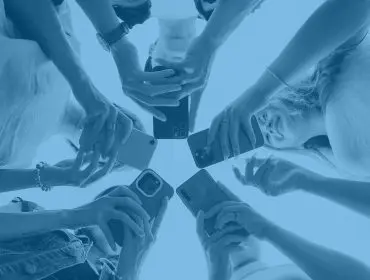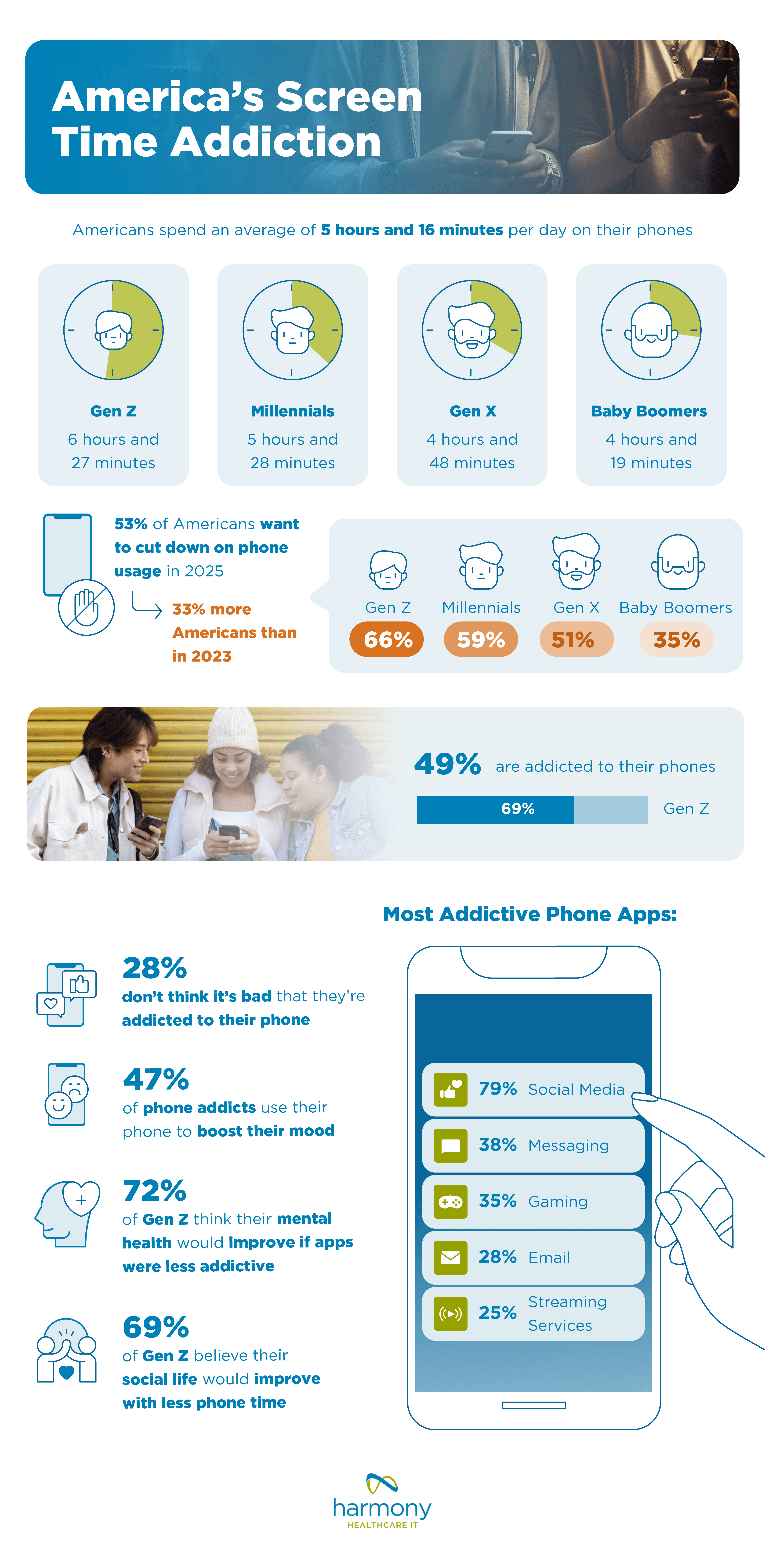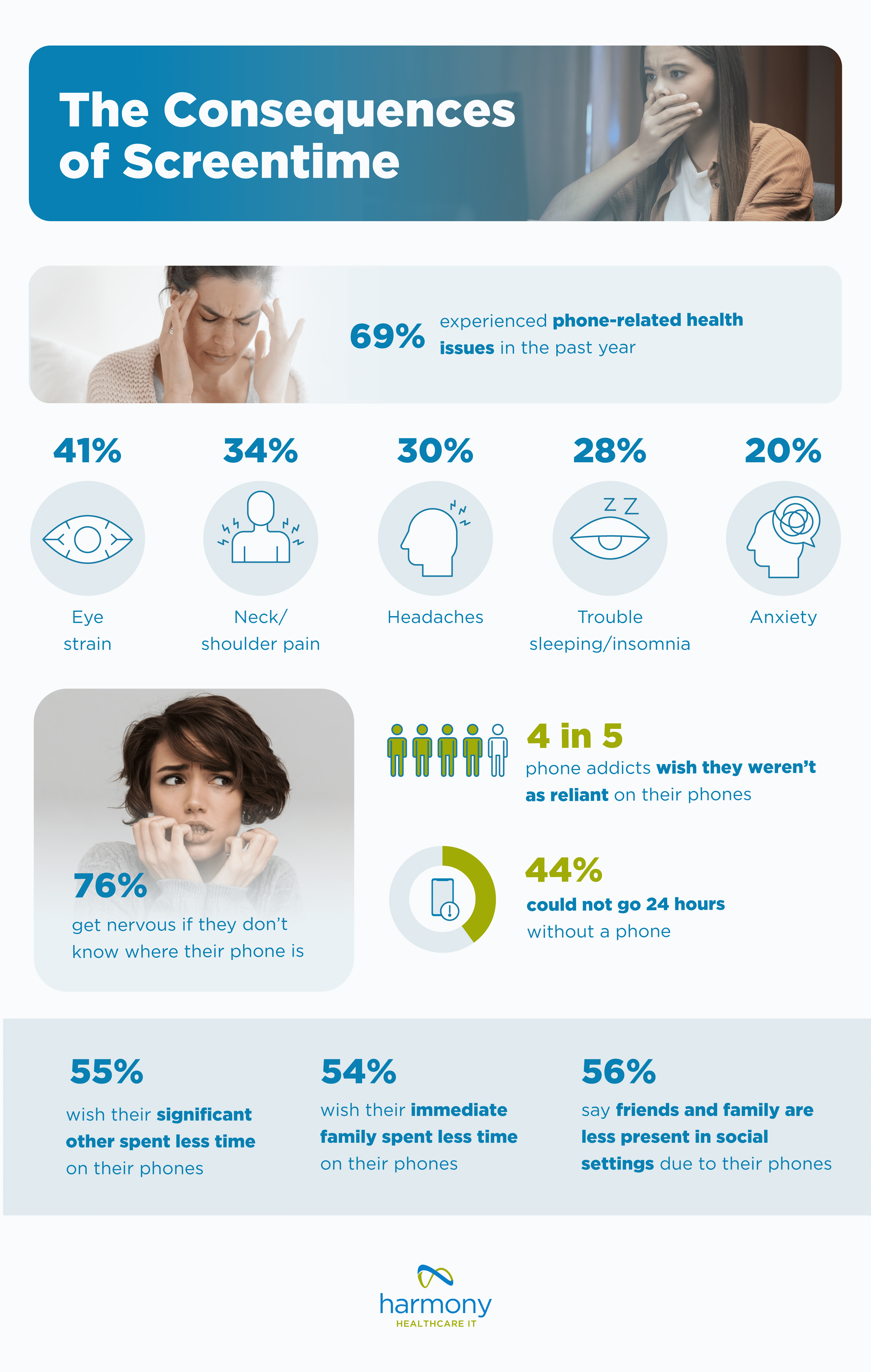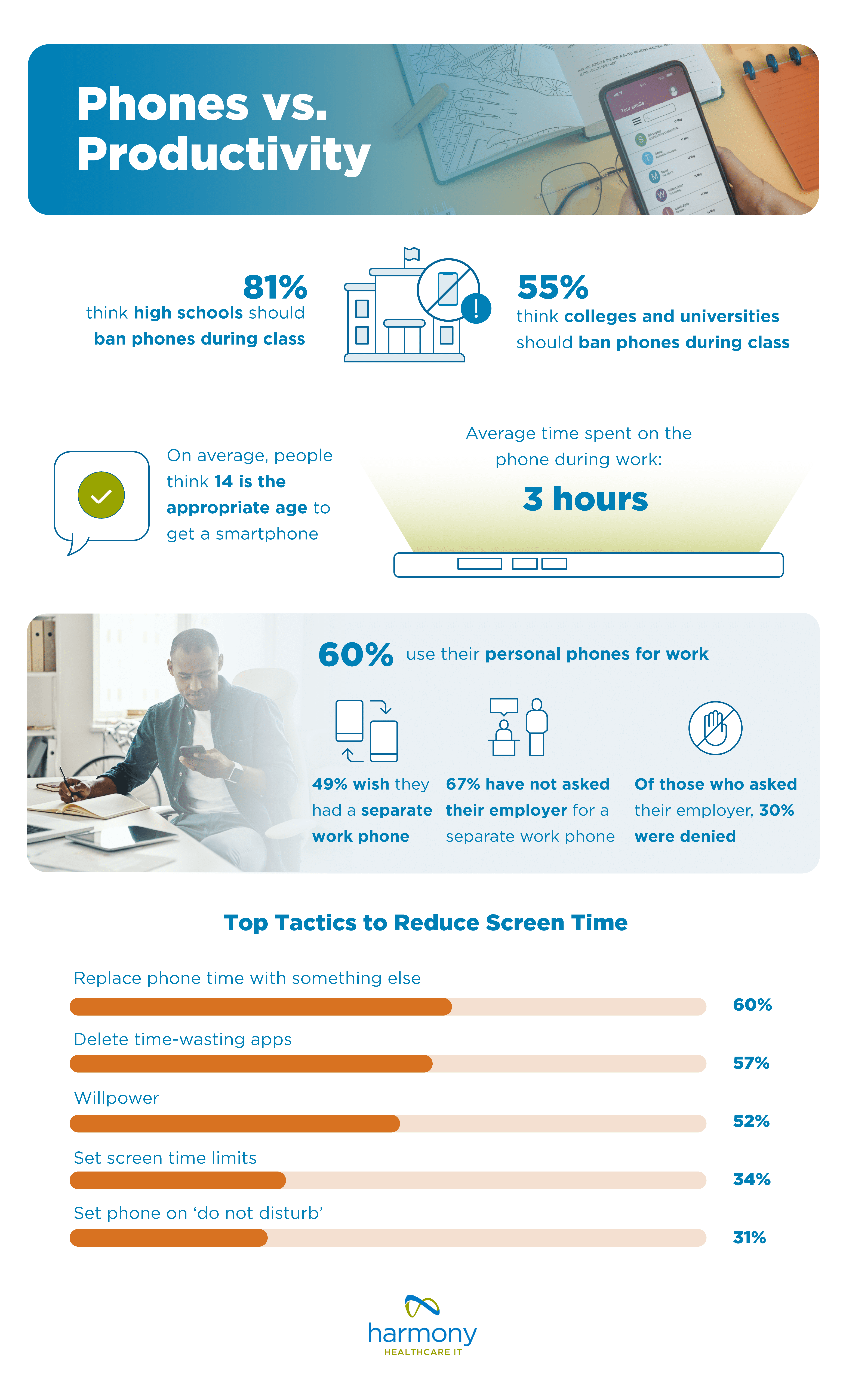
Phones are so much more than communication devices. They can operate as everything from payment systems to health data trackers to keys, levels, tuners, and even light switches. On top of these useful abilities, these devices can quickly become a time suck, drawing people in with social media, games, and streaming services.
Health experts recommend spending no longer than two hours a day staring at a screen, but our research finds that people spend more than double that on their phones daily. That’s before even taking into account time spent using computers and tablets or watching movies or TV shows on a physical television.
Average Time Spent on Phones
 Americans spend an average of 5 hours and 16 minutes per day on their phones – a 14% increase from the 4 hours and 37 minutes people reported spending on their phones in 2024. Age plays a significant role, with Gen Z spending the most time on their phones, and Baby Boomers spending the least. How much time does Gen Z spend on their phone? Gen Z spends 6 hours and 27 minutes on their phone every day while Baby Boomers spend a little over 4 hours (which is still double the recommended limit).
Americans spend an average of 5 hours and 16 minutes per day on their phones – a 14% increase from the 4 hours and 37 minutes people reported spending on their phones in 2024. Age plays a significant role, with Gen Z spending the most time on their phones, and Baby Boomers spending the least. How much time does Gen Z spend on their phone? Gen Z spends 6 hours and 27 minutes on their phone every day while Baby Boomers spend a little over 4 hours (which is still double the recommended limit).
Over half (53%) of Americans want to cut down on phone usage in 2025 (33% more than in 2023). The top 5 reasons Americans want to cut down on their phone use is to:
- Have better time management (67%)
- Improve mental health (64%)
- Increase focus & attention span (57%)
- Get better sleep (57%)
- Improve physical health (64%)
But this may not be as easy as people want it to be since 49% feel they’re addicted to their devices. However, over 1 in 4 Americans who admit to being addicted to their phone do not feel that it’s a bad thing. That may be because nearly half of self-proclaimed phone addicts use their devices to boost their mood.
With Gen Z spending the most time on their phones across all generations, they’re also the most dependent on their devices with 69% openly admitting to being addicted. While the battle to break away from your phone isn’t easy, the younger generation can see the potential benefits. Over 2 in 3 Gen Z believe their social life would improve with less phone time, and 72% of Gen Z think their mental health would improve if phone apps were less addictive. The app making it the hardest to walk away? Social media. 79% of Americans say social media is the most addictive phone app.
Why Should We Cut Back on Screen Time?

The top reason Americans want to cut back on their phone usage is because 2 in 3 want to make better use of their time and improve their time management. For others, it’s a matter of improving their health, both physically and mentally.
Health Issues
Whether you’re working on your computer or looking at your phone, hunching over and looking at screens for long periods is hard on the body. A study from the National Library of Medicine shows that prolonged use of smartphones could affect posture and respiratory function. Additionally, Mayo Clinic states that phone and computer time combined is bad for a person’s neck.
When asked about the impact of cell phone usage, over 2 in 3 (69%) have experienced a phone-related health issue in the past year. The most common maladies: eye strain, neck/shoulder pain, and headaches. Additionally, too much screen time has been shown to lead to sleep issues (28%) and anxiety (20%).
Unhealthy Attachment
Phone addictions can also prevent us from using our brains for simple tasks, navigating, and entertaining ourselves. The unhealthy attachment is something many wish they could do without. According to survey statistics, 3 in 4 (76%) get nervous if they don’t know where their phone is, and 44% could not go 24 hours without a phone. Of those who admit to having a cellphone addiction, data shows 4 in 5 wish they weren’t as reliant on their phones.
Social Impact
When it comes to social lives, 56% say friends and family are less present in social settings due to their phones. Additionally, 55% of people in a relationship wish their partner spent less time on their phones, and 54% wish their immediate family did the same.
The Impact of Phones on Our Daily Activities

According to a small Stanford study, children are getting their first phone around the age of 12. Our survey found that people believe 14 years old is the appropriate age to get a smartphone, and 81% think high schools should ban phones during the school day. Over half (55%) think colleges and universities should also ban phones during class.
Phones have a way of making people less productive as they creep their way into classrooms and offices. While these devices were designed initially to communicate, people now spend more time scrolling on their phones rather than using them to talk with others. Only 11% of survey respondents shared they primarily use their phone for productive activities.
On average, people estimate spending 3 hours per day on their phones during work hours. This doesn’t mean that people are slacking off while on the clock, 60% report using their personal phones for work. Nearly half (49%) wish they had a dedicated work phone, but 30% of those who asked their employer were denied. Meanwhile, 67% haven’t asked their employer for a work phone.
Self-regulation can be a solution to getting off phones and being more productive. In fact, 60% of Americans who wish to cut back on phone usage plan to replace phone time with something else, 57% plan to delete time-wasting apps, and 52% plan to leverage their willpower.
At the end of the day, it’s up to you to keep track of how much time you spend on your phone. Try to schedule screen breaks throughout your day and go without your phone for an hour. Time spent not looking at your phone screen can help create more in-person experiences and foster stronger relationships in 2025 and beyond.
Methodology
In December 2024, we surveyed 1,001 people about their phone screen time habits. Survey respondents were asked to look up their average daily screen time logged on their phone and report it as part of the survey. Ages ranged from 18 to 78 with an average age of 43. 25% were Baby Boomers, 25% were Gen X, 25% were Millennials, and 25% were Gen Z. 47% were women, 51% were men, 1% were nonbinary, and less than 1% would rather not say.
_____________________________________________________________
2023 Report: America’s Screen Time
In our 2023 report, we broke down screen time by generation, examined lifetime cell phone usage, and explored the top causes of phone addiction.
2023 Phone Usage Statistics
- 40% are trying to cut down on screen time in 2024
- 36% don’t think they could go 24 hours without a phone in 2023
- Screen time by generation in 2023:
- Gen Z: 6 hours and 5 minutes
- Millennials: 4 hours and 36 minutes
- Gen X: 4 hours and 9 minutes
- Baby Boomers: 3 hours and 31 minutes
- Americans spent an average of 4 hours and 37 minutes on their phones in 2023
2023 Phone Addiction Statistics
- 45% feel addicted to their phones in 2023
- 56% Gen Z
- 48% Millennials
- 44% Gen X
- 29% Baby Boomers
- 52% think they are too dependent on their phone in 2023
- Why Americans use their phone so much in 2023:
- 70% Entertainment
- 54% Boredom
- 41% Distraction
- 41% Habit
- 38% Connection
Methodology
In December 2023, we surveyed 1,024 people about their phone screen time habits. Survey respondents were asked to look up their average daily screen time logged on their phone and report it as part of the survey. Ages ranged from 18 to 77 with an average age of 43. 25% were Baby Boomers, 25% were Gen X, 25% were Millennials, and 25% were Gen Z. 52% were women, 45% were men, 2% were nonbinary, and 1% would rather not say.
For media inquiries, please contact media@digitalthirdcoast.net.
Fair Use
When using this data and research, please attribute by linking to this study and citing www.www.harmonyhit.com.






